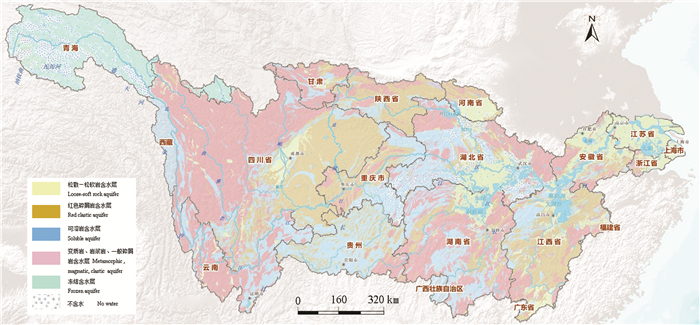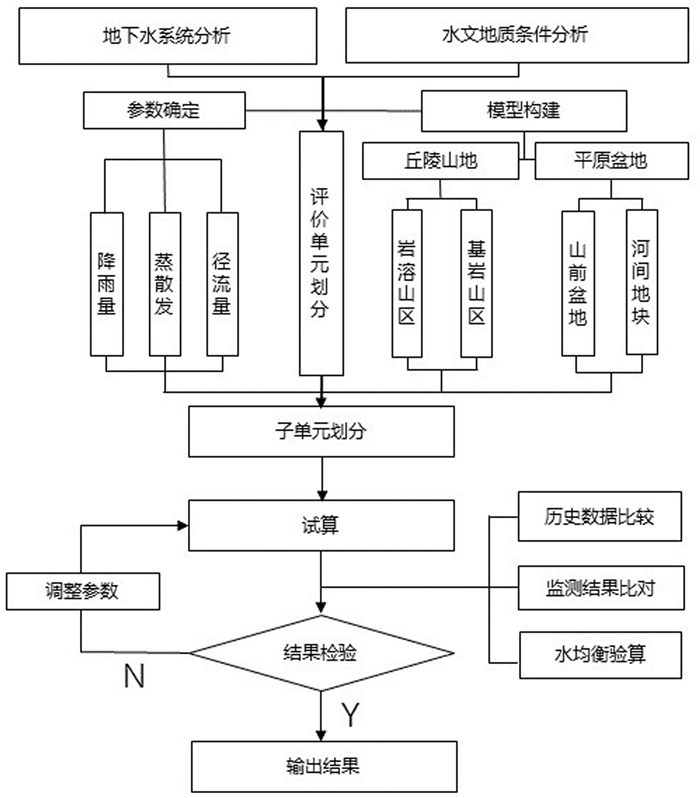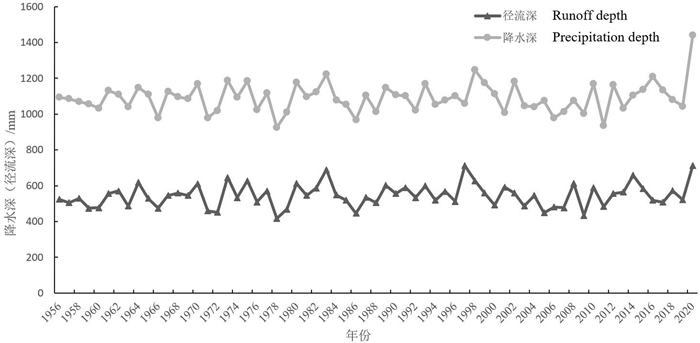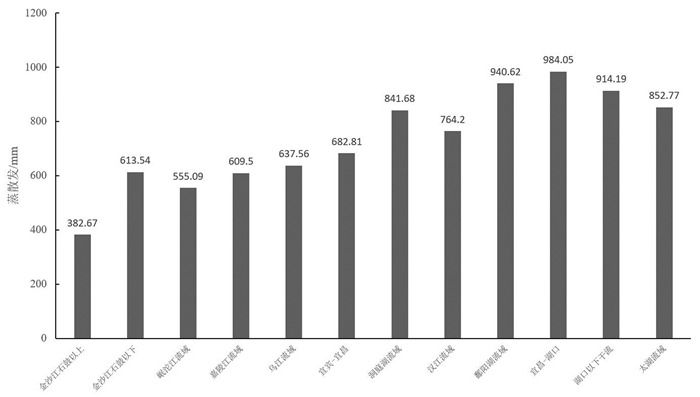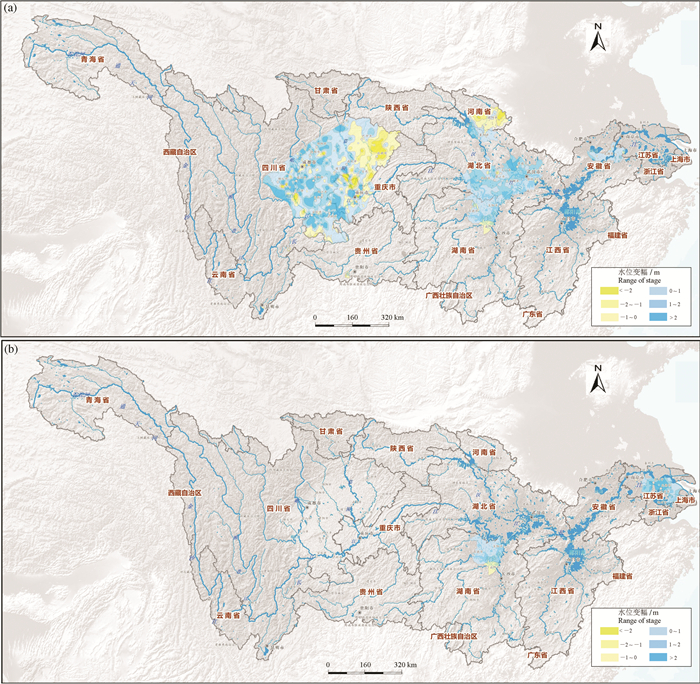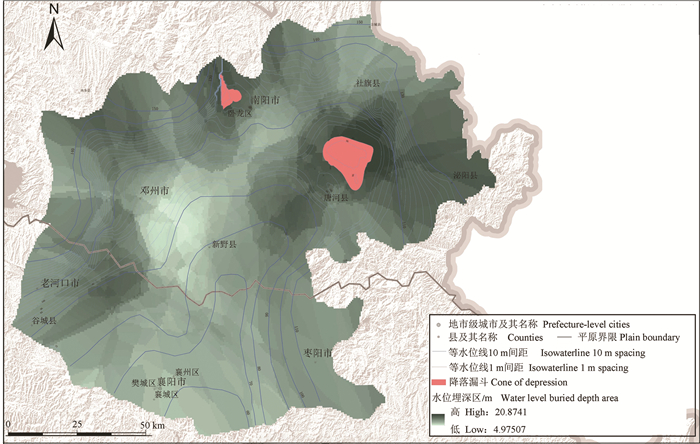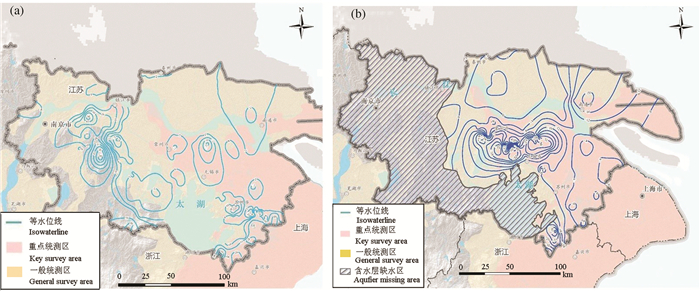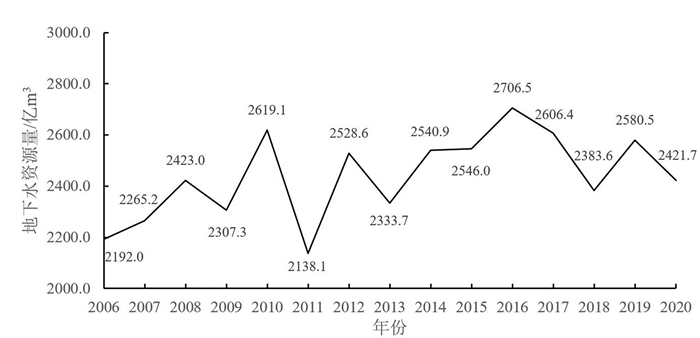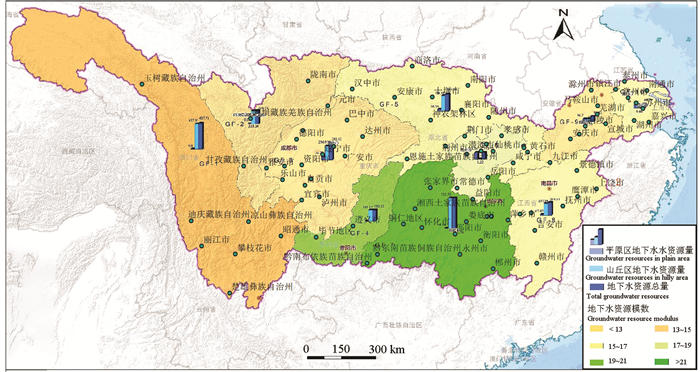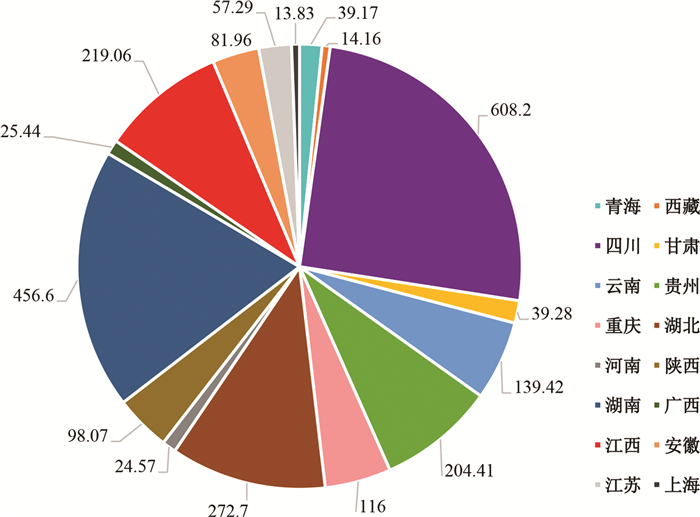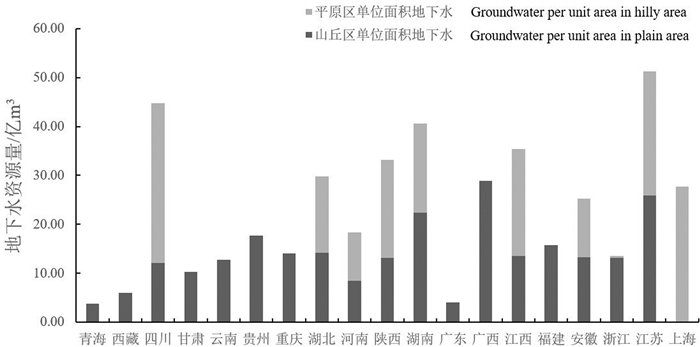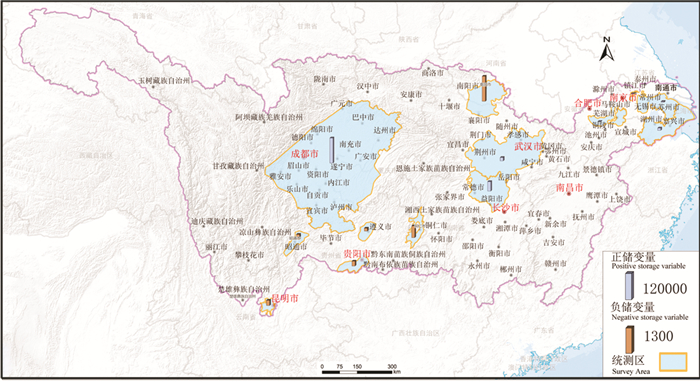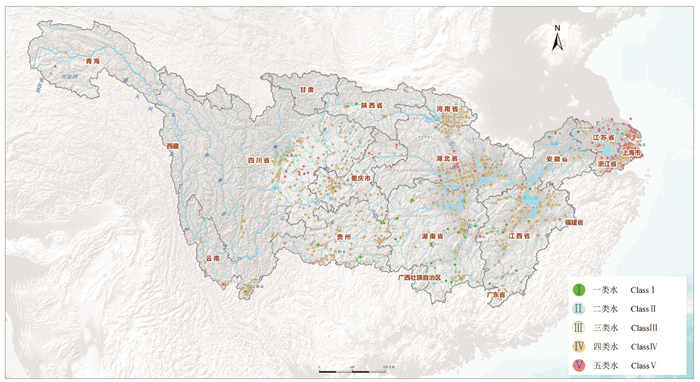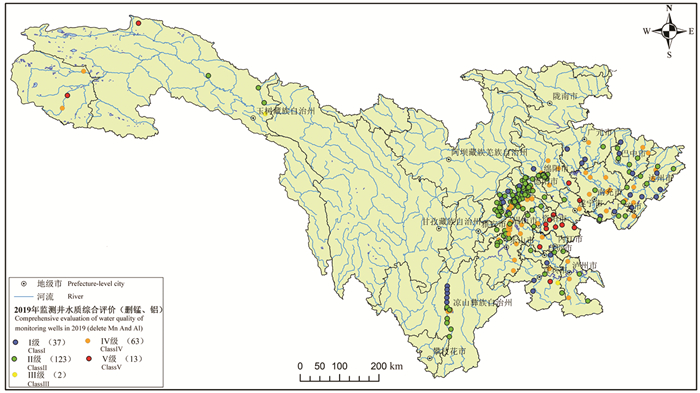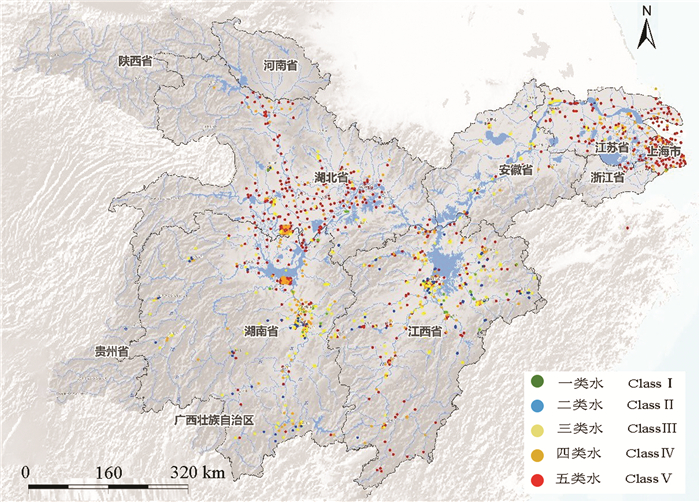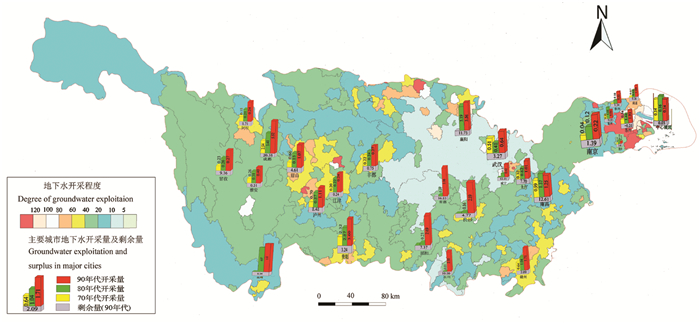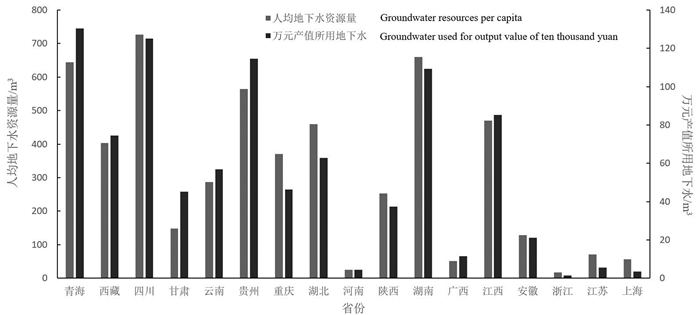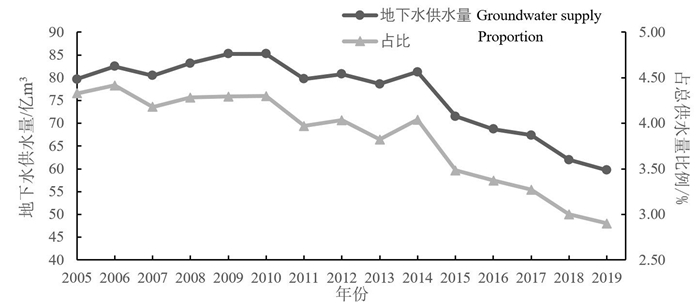Groundwater resources in the Yangtze River Basin and its current development and utilization
-
摘要:
为提升对长江流域水文地质和地下水资源的认知程度,突破以往单独从地表水或地下水角度进行评价的局限性,长江流域水文地质调查工程以地球系统科学理论和水循环理论为指导,充分考虑地表水与地下水的转化关系,将水文地质单元和地表水流域有机结合,划分长江流域地下水评价单元,建立典型地下水资源评价模型,开展了新一轮长江流域地下水资源评价。评价结果表明:(1)长江流域水循环要素时空分布不均,降水以中游最多,并由东南向西北递减;地表径流主要集中在夏季,且长江北岸比南岸集中程度更高;蒸散发量总体上呈现东部高于西部的特征,最大值集中在长江中游一带;长江流域地下水位总体保持稳定,丰枯季水位变化总体不大,一般小于2 m;长三角超采区的地下水漏斗面积已明显减小,相关环境地质问题得到了有效控制。(2)2020年长江流域的地下水资源总量2421.70亿m3/a,其中山丘区地下水资源量2092.79亿m3/a,平原区地下水资源量331.35亿m3/a;地下水储存量较2019年整体略有增加趋势,其中四川盆地最为明显,共增加23.72亿m3。(3)长江流域的水质上游优于下游,优质地下水主要分布在赣南地区和大别山南麓一带,部分地区水质较差的主要原因是原生劣质水的广泛分布。长江流域地下水开发利用水平整体很低,局部地区由于过往不合理的开发所引发的环境地质问题已得到缓解,岩溶塌陷、地面沉降等问题得到了较好控制。建议适当开发利用赣南地区和大别山南麓一带优质的基岩裂隙水。
Abstract:In order to improve the cognition of hydrogeology and groundwater resources in the Yangtze River Basin and break through the limitations of previous evaluation from the point of view of surface water or groundwater, the hydrogeology survey project in the Yangtze River Basin was guided by the earth system science theory and water cycle theory. Based on the full consideration of the transformation relationship between surface water and groundwater, hydrogeology unit and surface water basin were organically combined to divide groundwater evaluation units in the Yangtze River Basin. A new round of groundwater resource evaluation in the Yangtze River basin was carried out through the establishment of typical groundwater resource evaluation model. The evaluation results show that the spatial and temporal distribution of water cycle elements in the Yangtze River basin is uneven, with the highest precipitation in the middle reaches and decreasing from southeast to northwest. Surface runoff is mainly concentrated in summer, the north bank is higher than the south bank in summer concentration surface runoff. Evapotranspiration is generally higher in the east than in the west, and the maximum value is concentrated in the middle reaches of the Yangtze River. The groundwater level in the Yangtze River basin remains stable on the whole, and the water level changes little in the peak and dry seasons, generally less than 2 m. The area of groundwater funnel in the Yangtze River Delta over-exploitation area has been significantly reduced, and the related environmental geological problems have been effectively controlled. In 2020, the total groundwater resources in the Yangtze River Basin was 242.170 billion m3/a, including 209.279 billion m3/a in hilly areas and 33.135 billion m3/a in plain areas. Compared with 2019, the groundwater storage increased slightly, especially in Sichuan Basin, with a total increase of 2.372 billion m3. The water quality in the upper reaches of the Yangtze River basin is better than that in the lower reaches, and the high-quality groundwater is mainly distributed in southern Jiangxi and the western foothills of Dabie Mountains. The main reason for poor water quality in some areas is the widespread distribution of primary inferior water. The development and utilization level of groundwater in the Yangtze River Basin is very low as a whole. The environmental geological problems caused by unreasonable development in some areas have been greatly solved, and karst collapse and land subsidence have been well controlled. It is suggested that high-quality bedrock fissure water should be properly developed and utilized in southern Jiangxi and south Dabie Mountains.
-
1. 引言
稀土(Rare earth)是元素周期表中镧系元素和钪、钇共17种金属元素的总称。稀土是重要的自然资源,更是宝贵且关键的战略资源,在民用和军事方面用途十分广泛,同时也是先进装备制造业、新能源、新兴产业等高新技术产业不可或缺的原材料。在全球范围内,稀土资源分布不均,其主要分布于美国、俄罗斯、中国、印度、巴西等国家。中国稀土储量约占世界总储量的23%,却承担了世界90%以上的市场供应(中华人民共和国国务院新闻办公室, 2012)。经半个多世纪的过度开采,中国稀土资源保有储量及保障年限不断下降,鉴于此,发现和利用新类型稀土矿,可有效提高中国稀土资源储量,有力保障国家稀土资源供给安全。
稀土矿床按成因分类主要有碱性岩—碱性超基性岩型、碳酸岩型、花岗岩型、砂矿型以及风化壳型(徐光宪, 1995);按工业类型分类主要有稀土-磁铁矿矿床、含稀土碳酸岩矿床、花岗岩风化壳型稀土矿床、含稀土伟晶岩矿床、含稀土磷块岩矿床以及独居石砂矿床(矿产资源工业要求手册, 2014)。近年来,多位学者报道在贵州威宁地区二叠系宣威组一段黏土岩中富含稀土元素,但是由于该稀土资源的综合利用技术多年来未取得突破(黄训华, 1997; 张震和戴朝辉, 2010; 周灵洁, 2012),稀土元素的赋存状态、富集机理以及稀土矿床成因类型等方面存在较大争议。2018年以来,笔者在滇东—黔西地区开展地质调查,发现研究区内广泛发育的二叠系宣威组富稀土黏土岩系属沉积成因,有别于Wang et al.(2018)提及的南方离子吸附型稀土矿,而类似于文俊等(2021)报道的川南沐川地区宣威组底部古风化壳-沉积型铌、稀土矿,该新类型稀土矿具有矿石禀赋好、矿层厚度大且较连续、“关键稀土元素(Critical rare earth element; Pr, Nd, Tb, Dy)”占比较高等特点,并伴生有铌、锆、镓等有价元素,其中镓的平均品位高达70.5×10-6,高于工业品位(Zhang et al., 2010)。另外,在稀土资源开发利用方面取得了重大突破,针对该稀土资源研发了“选择性浸出”新工艺(徐璐等, 2020),使稀土回收率可达90%以上,该新类型稀土资源有望实现规模化工业利用。滇东—黔西地区沉积型稀土资源的发现与利用,将有力支撑国家关键稀土资源战略储备。
2. 区域地质背景
滇东—黔西地区大地构造位置位于扬子板块西缘(潘桂棠等, 2009),以北西向康定—水城断裂、北东向弥勒—师宗深大断裂带以及近南北向小江断裂所挟持的三角形地带(图 1)。区内地层属华南地层大区的扬子地层区之上扬子地层分区,主体位于黔西北地层小区,部分涉及到云南的昭通地层小区及曲靖地层小区。晚中生代以前主要是海相碳酸盐岩及陆源硅质碎屑岩,以后则主要为陆相沉积。火成岩主要为海西晚期陆相溢流的峨眉山玄武岩及同源异相的浅成侵入岩。
![]() ①—怒江断裂;②—金沙江—红河断裂;③—鲜水河断裂;④—龙门山山前断裂;⑤—小金河断裂;⑥—箐河—程海断裂;⑦—安宁河—绿汁江断裂;⑧—小江断裂;⑨—康定—水城断裂;⑩—弥勒—师宗断裂Figure 1. Sketch map showing geotectonic position of the research area (after Luo Yaonan, 1985; Zhang Zhibin et al., 2006)①-Nujiang fault; ②-Jinsha River—Red River fault; ③-Xian Shui River fault; ④-Longmen Mountain piedmont fault; ⑤-Xiao Jian River fault; ⑥-Jing River—Chenghai fault; ⑦-Anning River—Lü zhi River fault; ⑧-Xiao River fault; ⑨-Kang ding—Shui cheng fault; ⑩-Mile—Shizong fault
①—怒江断裂;②—金沙江—红河断裂;③—鲜水河断裂;④—龙门山山前断裂;⑤—小金河断裂;⑥—箐河—程海断裂;⑦—安宁河—绿汁江断裂;⑧—小江断裂;⑨—康定—水城断裂;⑩—弥勒—师宗断裂Figure 1. Sketch map showing geotectonic position of the research area (after Luo Yaonan, 1985; Zhang Zhibin et al., 2006)①-Nujiang fault; ②-Jinsha River—Red River fault; ③-Xian Shui River fault; ④-Longmen Mountain piedmont fault; ⑤-Xiao Jian River fault; ⑥-Jing River—Chenghai fault; ⑦-Anning River—Lü zhi River fault; ⑧-Xiao River fault; ⑨-Kang ding—Shui cheng fault; ⑩-Mile—Shizong fault3. 测试分析方法
在研究区内采集了186件宣威组一段沉积型稀土矿石样品,正样经破碎研磨至200目,取缩分样50 g/件,送至中国地质科学院矿产综合利用研究所分析测试中心,利用电感耦合等离子体质谱仪(Perkinelmer Optima Nexion 350X)测得稀土配分数据;再取稀土含量(TREO)较高的毛家坪矿点、鱼布沟矿点缩分样20 g/件,送至中国地质科学院矿产综合利用研究所岩石与工艺矿物学研究室,利用X射线衍射仪(日本理学Ultima Ⅳ)测得主要矿物成分。选取稀土含量(TREO)较高的毛家坪矿点、鱼布沟矿点矿石副样,块样用切割机(MecatomeT330)切成3 cm×1 cm×2 cm样品,用环氧树脂镶嵌制光片坯样;松散样经研磨至40目,用环氧树脂镶嵌制砂片坯样。以上坯样用自动磨抛机(EcomeT300)制得直径为3.5 cm圆柱形待测样品,将待测样品送至中国地质科学院矿产综合利用研究所岩石与工艺矿物学研究室,利用英国蔡司(ZEISS)Sigma 500型场发射扫描电镜及配套的德国布鲁克能谱仪(EDS)获取数据,并应用矿物特征自动定量分析软件(AMICS)进行矿物参数全自动定量分析。
4. 稀土资源特征
4.1 富稀土岩系特征
研究区内富稀土岩系发育于二叠系宣威组一段(P3x1)。宣威组出露面积较广(图 2),北至昭通金阳—大关一带,向南经昭通、威宁一直延伸至宣威—六盘水等地,呈北窄南宽的形态展布。宣威组平行不整合于二叠系峨眉山玄武岩组(P2-3em)之上、整合于三叠系东川组(T1dc)之下,是一套乐平世滨岸及湖沼相与同期曲流河相伴生产出的沉积地层,并且多出现在河泛平原背景上,无独立的大型湖泊沉积体系(戴传固, 2017)。
据笔者对威宁县哲觉镇小箐沟(东经103°59′ 08″,北纬26°36′37″)二叠系宣威组一段典型地层剖面(Pm201)研究,查明宣威组一段富稀土岩系主要为灰白色铝土质黏土岩与粉砂质黏土岩互层(图 3a、b),偶见植物碎屑,中部夹砾屑砂岩(图 3f),砾屑呈次圆状,粒度2~4 mm不等,由下往上砾屑粒度表现出粗—细—粗的渐变特征;岩石碎裂呈砂状、松散片状(图 3c),局部可见层理构造;稀土含量较高的岩石主要为铝土质黏土岩(图 3d、e)、粉砂质黏土岩(⑨~⑪层,⑬~⑮层)。
![]() 图 3 贵州威宁哲觉镇宣威组一段(P3x1)剖面-柱状图a—宣威组一段典型剖面;b—宣威组一段柱状图;c、d、e—铝土质黏土岩;f—砾屑砂岩Figure 3. Typical profile and histogram of the first part of Xuanwei Group (P3x1) in the Zhejue town of Weining area, Guizhou Provincea-Typical section of the first part of Xuanwei Group; b-Histogram of the first passage of Xuanwei Group; c, d, e-Bauxitic clay rock; f-Gravel sandstone
图 3 贵州威宁哲觉镇宣威组一段(P3x1)剖面-柱状图a—宣威组一段典型剖面;b—宣威组一段柱状图;c、d、e—铝土质黏土岩;f—砾屑砂岩Figure 3. Typical profile and histogram of the first part of Xuanwei Group (P3x1) in the Zhejue town of Weining area, Guizhou Provincea-Typical section of the first part of Xuanwei Group; b-Histogram of the first passage of Xuanwei Group; c, d, e-Bauxitic clay rock; f-Gravel sandstone4.2 矿石特征
研究区沉积型稀土矿石主要为深灰—灰白色铝土质黏土岩(图 3c、d、e),具微细粒—隐晶质结构、鳞片状、块状构造。据偏光显微镜、X射线衍射仪、扫描电镜(图 4a)、AMICS矿物分析系统等仪器综合测试分析,结果显示矿石由黏土矿物(高岭石≈83%、埃洛石≈2%、伊利石 < 1%、绿泥石 < 1%)、金属氧化物(锐钛矿≈5%、褐铁矿≈1%、磁铁矿 < 1%、水铝石 < 1%)、硅酸盐矿物(石英+蛋白石 < 4%、火山玻璃≈2%)、金属硫化物(黄铁矿≈0.2%)以及其他方解石、针铁矿等微量矿物组成(徐莺等, 2018)。另外,偶见极少量的氟碳铈矿(图 4b)、方铈矿、磷铝铈矿等独立稀土矿物,其总含量 < 0.1%;以及少量锆石、磷灰石、金红石等含稀土元素的非独立稀土矿物,其总含量 < 1%。
4.3 稀土资源潜力
本文作者在研究区内优选二叠系宣威组(P3x)出露较好的区域,通过32个探槽工程、6个剥土工程地表控制及22个钻探工程深部验证,初步查明研究区二叠系宣威组(P3x)一段稀土矿层厚度2~18 m不等,单个矿石样品TREO含量最高为1.6%,圈定三处稀土矿找矿靶区(图 5):
(1)Ⅰ号找矿靶区:该靶区矿体形态呈层状、似层状,圈定一个矿体,矿体倾角26°~31°,矿体厚度2.96~18.92 m,矿体在地表出露较连续,沿走向延伸可达8 km,矿体TREO加权平均品位为0.21%(边界品位:0.18%,下同),该找矿靶区内推断资源量约4万t,矿床规模达小型。
(2)Ⅱ号矿找矿靶区:该靶区矿体形态呈层状、似层状,共圈定出上下两个矿层、三个矿体,矿体倾角12° ~17°,矿体TREO加权平均品位0.23% ~ 0.39%,矿体厚度5.85~9.23 m,其中主矿体沿倾向延伸可达1.6 km,该找矿靶区内推断资源量约25万t,矿床规模达中型,并具有达大型的潜力。
(3)Ⅲ号找矿靶区:该靶区矿体形态呈层状、似层状,共圈定出上下两个矿层、十个矿体,矿体倾角4° ~10°不等,矿体TREO加权平均品位0.18% ~ 0.46%,矿体厚度1.29~2.99 m。其中主矿体在地表出露连续,深部钻探控制也较稳定,沿倾向延伸可达2 km,该找矿靶区内推断资源量约2万t,矿床规模为小型。
综上所述,该区稀土资源规模大,矿体埋藏浅,产状较缓且连续,有利于大规模露天开采。
笔者在研究区内、找矿靶区以外的昭通、鲁甸、威宁炉山—东风—二塘、六盘水大湾、宣威大井等地(图 2),采集了宣威组一段铝土质黏土岩样品,分析结果显示均有稀土矿化异常,十余处稀土TREO品位超0.1%,最高品位0.42%,算数平均品位0.2%,矿体出露厚度2~6 m不等,推测滇东—黔西地区沉积型稀土资源找矿潜力巨大,远景资源量超100万t。
4.4 稀土配分及资源对比
物源区岩石经风化剥蚀形成的碎屑物质再搬运至沉积区沉积成岩,通常沉积岩继承了物源区岩石的稀土配分特征,风化和成岩作用对沉积岩中稀土元素再分配影响不大(Mclennan, 1993),所以稀土可作为一种有效的示踪物质。
在研究区内优选4条宣威组典型剖面(Pm101、Pm104、Pm205、Pm207),逐层采集岩石样品,分别按玄武岩、铁质黏土岩、铝土质黏土岩、黏土质粉砂岩、炭质黏土岩和砾岩进行稀土元素球粒陨石标准化,从稀土配分模式(图 6)可以看出宣威组富稀土岩系中所有样品均与峨眉山玄武岩均具有相对富集轻稀土元素、亏损重稀土元素、呈现右倾模式的特征;不同的是,大部分铁质黏土岩、黏土质粉砂岩与玄武岩具有更加相近的配分模式,即都只表现出轻微的负Eu异常;而铝土质黏土岩层作为主要的含矿层却表现为明显的负Eu异常(田恩源等, 2020)。
![]() 1—玄武岩;2—铁质粉砂质黏土岩;3—铝土质黏土岩;4—炭质粘土岩;5—黏土质粉砂岩;6—砂质砾岩Figure 6. Chondrite-normalized REE patterns of the samples (modifiled from Tian Enyuan et al., 2020; standardized values modifiled from Sun and McDonough, 1989)1-Basalt; 2-Fe-Silty clay rock; 3-Bauxitic clay rock; 4-Carbonaceous clay rock; 5-Clayey siltstone; 6-Sandy conglomerate
1—玄武岩;2—铁质粉砂质黏土岩;3—铝土质黏土岩;4—炭质粘土岩;5—黏土质粉砂岩;6—砂质砾岩Figure 6. Chondrite-normalized REE patterns of the samples (modifiled from Tian Enyuan et al., 2020; standardized values modifiled from Sun and McDonough, 1989)1-Basalt; 2-Fe-Silty clay rock; 3-Bauxitic clay rock; 4-Carbonaceous clay rock; 5-Clayey siltstone; 6-Sandy conglomerate滇东—黔西地区沉积型稀土矿石中关键稀土元素(CREO)高于国内正在开发利用的四川冕宁碳酸岩型、白云鄂博碳酸岩型、山东微山碳酸岩型以及部分南方离子吸附型等大型、超大型稀土矿床,同样也高于国外即将开发利用的美国芒廷帕斯碳酸岩型、格陵兰岛碱性岩型等超大型稀土矿床。另外,该沉积型稀土资源与离子吸附型、古砂矿型稀土矿对比,在矿石品位、资源规模、集中程度、开采方式、环境影响等方面具有较大的优势,其开发前景巨大(图 7a、b)。
表 1 世界典型稀土矿床对比表Table 1. Comparison table of typical rare earth deposits in the world
5. 开发利用潜力
笔者开展该沉积型稀土矿原矿铵盐浸出对比实验,结果表明稀土原矿中仅有少量(< 5%)稀土元素以离子吸附状态赋存于矿石中。通过多轮技术攻关,利用选择性浸出技术控制焙烧温度和焙烧时间,准确破坏稀土矿中高岭石的特定结构,脱去其层状结构中的羟基,变为高活性的偏高岭石,但偏高岭石仍保持了片状的结构特征。焙烧温度低于550℃,高岭石未转化为偏高岭石,稀土无法有效浸出,焙烧温度高于850℃,高岭石结构被完全破坏,硅和铝晶型会发生变化,对稀土元素进行重新包裹,导致稀土元素无法有效浸出,焙烧过程中不使用添加剂避免产生额外的有害废气。该技术通过协同控制焙烧和浸出条件,选择性浸出偏高岭石中的稀土元素,稀土元素浸出率高于90%,同时主要杂质铝、铁、钛和硅浸出率均<5%,有效抑制杂质大量进入富稀土料液。该技术申请了国家发明专利(徐璐等, 2020)。该技术的推广应用,有望使研究区内的稀土资源实现规模化工业利用。
6. 讨论
6.1 成因探讨
滇东—黔西地区稀土矿的成因研究程度不高,且存在较大争议,目前主要有三种观点:一是风化淋滤型,杨瑞东等(2006)、王伟(2008)以及Yang et al.(2008)通过分析稀土含矿层的地球化学特征,认为该矿床属与峨眉山玄武岩有关的风化壳型,峨眉山玄武岩及凝灰岩被强烈风化淋漓形成高岭石黏土岩,母岩中辉石的稀土元素被解析出来,被高岭石颗粒吸附,使稀土富集,形成稀土矿床;葛枝华(2018)同样赞同风化淋滤型稀土的观点,认为玄武岩风化过程实质就是一种脱硅富铝的过程,辉石、长石类矿物强烈分解,铁铝钛等氧化物明显增加,Ca、Na、Mg、K强烈迅速淋失,SiO2的含量不断降低,元素的迁移活动顺序是CaO>MgO>Na2O>SiO2,认为稀土元素通过风化淋滤作用在风化壳中不断富集起来。二是沉积-改造型,张海(2014)认为稀土矿床的形成与母岩的风化作用、沉积成岩作用以及地下流体作用有关,是沉积-再造型稀土矿床;黄训华(1997)、周灵洁(2012)、张海(2014)、吴承泉等(2019)通过稀土物源、地球化学特征分析,认为稀土矿物源不仅是峨眉山玄武岩,还应包括后期喷发的中酸性火成岩,经风化剥蚀后形成富集稀土的玄武岩质、凝灰质及少量长英质碎屑,经水介质搬运至沉积盆地形成高岭石硬质黏土岩,成岩过程中遭受一定程度的热液蚀变,促进稀土元素再富集;三是部分学者通过对比研究二叠纪峨眉山玄武岩及其同期长英质凝灰岩的地球化学特征,认为稀土异常富集与峨眉山玄武岩同期的碱性岩浆活动产生的凝灰岩有关,并接受了后期低温热液改造(Xu et al., 2001; Zhou et al., 2002; Long et al., 2004; Dai et al., 2010; Zhao et al., 2016)。
笔者研究发现,区域上宣威组富稀土岩系整体呈层状产出,从滇东到黔西横向演化和相变特征清晰;富稀土岩系底部常见河道相砾岩,辫状河沉积体系发育,层内偶见植物碎屑化石,层间发育水平层理等典型沉积构造;稀土含量较高的岩石主要为灰白色铝土质黏土岩,矿物组成主要为高岭石以及少量来自玄武岩及凝灰岩的典型矿物;由稀土配分模式看出铁质黏土岩和黏土质粉砂岩与玄武岩相比具有继承性,而铝土质黏土岩呈现出有别于玄武岩的明显负Eu异常特征(田恩源等, 2020);滇东—黔西地区位于上扬子陆块西缘,晚震旦世以来,长期处于相对稳定的台地沉积环境,区内无岩浆活动,不具备热液型稀土及南方离子吸附型稀土的成矿条件。基于以上认识,本文认为峨眉山玄武岩及同期的凝灰岩为富稀土岩系提供了主要的物质来源,而富稀土岩系中铝土质黏土岩很可能在沉积成岩过程中混入了大量上地壳富稀土物源区的物质,使得铝土质黏土岩中稀土异常富集。综上所述,本文认为滇东—黔西地区稀土资源成因类型为沉积型,是一种新类型的稀土资源。
6.2 稀土元素赋存状态
该稀土矿中稀土元素的赋存状态存在较大争议,前人分析矿石中稀土元素含量的高低可能与矿物组分有密切关系(周灵洁, 2012; Zhou et al., 2013; Zhang et al., 2016; Zhao et al., 2016, 2017; He et al., 2018)。在风化过程中,如果含稀土元素的副矿物抗风化能力弱,稀土元素则容易从副矿物中释放出来,以离子形式迁移富集于黏土矿物中,黏土矿物含量越高,稀土含量往往也相应比较高,稀土含量与黏土矿物含量就有较高的正相关性,据此推测认为稀土元素极有可能以离子吸附相和富含稀土元素的残余独立矿物相组成,与高岭石等黏土矿物含量密切相关;徐莺等(2018)利用电子探针、X射线衍射等现代分析测试手段并结合矿石选冶试验,认为稀土元素以类质同象为主、离子吸附相为辅的形式赋存于高岭石质黏土岩中;黄训华(1997)、吴承泉等(2019)通过分析在强烈风化条件下母岩被解析形成的稀土元素可能存在的赋存状态,认为稀土元素可能以离子吸附态、胶体吸附态等的混合态赋存于高岭石硬质黏土岩中。以上研究并未提供确凿证据证明稀土元素赋存状态。本文作者开展多组原矿铵盐浸出对比实验,稀土元素浸出率不超过20%,间接说明了稀土原矿中以离子吸附态赋存的稀土元素占比很低;据矿石岩矿鉴定,查明以独立稀土矿物形式赋存的稀土元素占比<0.1%,以类质同像(非独立稀土矿物)形式赋存的稀土元素占比也很低;而通过550℃~850℃焙烧选择性浸出技术,准确破坏稀土元素载体矿物——高岭石的特定结构,稀土元素浸出率高于90%。基于以上研究,推测稀土元素极有可能以某种形态赋存于高岭石矿物晶体层间间隙中。
6.3 关键稀土元素及其价值
随着全球新材料、新技术、新能源、高新电子、高端装备制造、先进军事装备等战略性产业迅猛发展,加快了对原材料的结构性调整,一批新兴战略性关键矿产成为各国竞相争夺的资源。根据稀土各元素特有的性质,轻稀土中的Pr、Nd,重稀土中的Tb、Dy等元素由于其在高强度永磁行业、新能源汽车产业、高端声光电材料等方面具备不可替代的地位,这些制约着全球新兴产业、高新科技健康发展的稀土元素称之为“关键稀土元素(CREE)”。据上海有色网公布的2020年6月稀土氧化物实时交易均价(据上海有色网未公布Tm2O3、Yb2O3、Lu2O3成交均价)显示(图 8),Pr、Nd、Tb、Dy关键稀土氧化物价格分别29.5万元/t、28.0万元/t、419万元/t、194万元/t,合计约占所有单一稀土氧化物价格总和的88%,可见关键稀土元素具有极高的经济价值和重要的战略地位。
滇东—黔西地区发现的沉积型稀土矿具有矿层厚、矿石品位高、资源潜力大、矿石中关键稀土元素(CREE)占比高等特点,特别是矿石选冶新工艺取得重大突破,使该类型稀土矿可能实现规模化工业利用。该沉积型稀土矿的发现既丰富了全球稀土资源工业类型,又支撑了国家关键稀土资源战略储备。
7. 结论
(1)滇东—黔西地区发育于二叠系宣威组的稀土矿,其成因类型属沉积型。
(2)稀土元素极有可能以某种形式赋存于高岭石矿物晶体层间间隙中。
(3)该沉积型稀土矿具有矿体厚度大、矿石品位高、资源潜力大、开采成本低、矿石中关键稀土元素(CREO)占比高等优点,其开发利用前景较好。
(4)该沉积型稀土资源的发现既丰富了全球稀土资源工业类型,又支撑了国家关键稀土资源战略储备。
-
表 1 长江流域主要含水层划分
Table 1 Division of main aquifer in Yangtze River Basin

表 2 长江流域地下水资源计算分区(个)
Table 2 Calculation zonation of groundwater resources in Yangtze River basin

表 3 长江流域1956—2020年年均降水深变化
Table 3 Variation of annual average precipitation depth in Yangtze River Basin from 1956 to 2020

表 4 2020年长江流域二级评价分区地下水资源量(亿m3)统计
Table 4 Statistics of groundwater resources (108m3)in secondary evaluation division of Yangtze River Basin in 2020

表 5 长江流域各省地下水资源量(亿m3)统计
Table 5 Statistics of groundwater resources (108m3) in each province of the Yangtze River Basin

表 6 长江流域2019—2020年主要平原盆地地下水储变量
Table 6 Chang of the groundwater storage variables in main plain basins in Yangtze River Basin from 2019 to 2020

表 7 长江流域地下水(个数)水质统计
Table 7 Statistics of groundwater quality in Yangtze River Basin

-
Cao Jianwen, Xia Riyuan, Tang Zhonghua, Zhao Liangjie, Wang Zhe, Luan Song, Wang Song. 2021. Groundwater resources in Guangdong-Hong Kong-Macao Greater Bay Area and its development potential[J]. Geology in China, 48(4)1075-1093(in Chinese with English abstract).
Changjiang Water Resources Commission, Ministry of Water Resources. 2018. Water resources bulletin of Yangtze River Basin and Southwest Rivers (1998-2018). Wuhan: Changjiang Water Resources Commission(in Chinese).
Chen Fan, Chen Li, Zhang Wei, Han Jianqiao, Wang Junzhou. 2019. Responses of channel morphology to flow-sediment variations after dam construction: A case study of the Shashi Reach, middle Yangtze River[J]. Hydrology Research, 50(5): 1359-1375. doi: 10.2166/nh.2019.066
Fan Kexu, Xu Changjiang, Zhang Jing. 2011. Evaluation of Water Resources Quality in Yangtze River Basin[J]. Yangtze River, 42(18): 62-64, 72 (in Chinese).
Gao Yu, Chen Li, Zhang Wei, Li Xin, Xu Quanxi. 2021. Spatiotemporal variations in characteristic discharge in the Yangtze River downstream of the Three Gorges Dam[J]. The Science of the Total Environment, 785: https://doi.org/10.1016/j.scitotenv.2021.147343.
Ge Jianzhong, Zhang Jingsi, Chen Changsheng, Ding Pingxing. 2021. Impacts of fluvial flood on physical and biogeochemical environments in estuary-shelf continuum in the East China Sea[J]. Journal of Hydrology, 598: https://doi.org/10.1016/j.jhydrol.2021.126441.
Gong Lei, Wang Xinfeng, Song Mian, Li Hongyan, Xiao Zeyou, Hu Qifeng, Wang Jin, Wu Linwei, Wang Lei, Miu Sai. 2019.1: 50000 hydrogeological survey data set of Xingguo and Ningdu in Southern Jiangxi[J]. Geology in China, 46(S1): 11-17 (in Chinese).
Han Yufang, Lu Chuanteng. 2019. Characteristics of water and sediment changes and riverbed evolution in the Yangtze River after the Three Gorges Project[C]//The 19th China Symposium on Ocean (Shore) Engineering, Chongqing, China (in Chinese with English abstract).
Hu Baoyi, Wang Lei. 2021. Terrestrial water storage change and its attribution: A review and perspective[J]. Water Resources and Hydropower Engineering, 52(5): 13-25(in Chinese with English abstract).
Hu Peng, Tao Junyu, Ji Aofei, Li Wei, He Zhiguo. 2021. A computationally efficient shallow water model for mixed cohesive and non-cohesive sediment transport in the Yangtze Estuary[J]. Water, 13(10): https://doi.org/10.3390/w13101435.
Jiang Yuehua, Lin Liangjun, Chen Lide, Yi Huayong, Ge Weiya, Cheng Hangxin, Zai Gangyi, Wang Guiling, Ban Yizhong, Li Yuan, Lei Mingtang, Tan Cheng. 2017. Research on conditions of resources and environment and major geological problems in the Yangtze River Economic Zone[J]. Geology in China, 44(6): 1045-1061(in Chinese with English abstract). http://en.cnki.com.cn/Article_en/CJFDTOTAL-DIZI201706002.htm
Jiang Yuehua, Zhou Quanping, Chen Lide, Ni Huayong, Lei Mingtang. Cheng Heqin, Shi Bin. Ma Teng. Ge Weiya. Su Jingwen, Li Yun. Tan Jianming. 2019. Progress and main achievements of geological environment comprehensive investigation project in Yangtze River Economic Belt[J]. Geological Survey of China, 6(5): 1-20 (in Chinese with English abstract). http://en.cnki.com.cn/Article_en/CJFDTotal-DZDC201905001.htm
Jing Jiajun, Guan Zhen, Shan Yuyang, Jing Jiayuan. 2019. Present situation of groundwater exploitation and utilization and analysis of potential water sources in abundant plain area[J]. Geological Survey of China, 6(3): 87-91 (in Chinese with English abstract).
Li Haitao, Feng Wei, Wang Kailin, Zhao Kai, Li Gang, Zhang Yuan, Li Muzi, Sun Lu, Chen Yichao, You Bing. 2021. Background, characteristics, and exploitation potential of groundwater resources in Xiong'an New Area[J]. Geology in China, 48(4): 1112-1126(in Chinese with English abstract).
Li Shengpin, Li Wenpeng, Yin Xiulan. 2019. Distribution and evolution characteristics of national groundwater quality from 2013 to 2017[J]. Hydrogeology and Engineering Geology, 46(6): 1-8 (in Chinese with English abstract). http://en.cnki.com.cn/Article_en/CJFDTotal-SWDG201906002.htm
Li Xiaoqian, Gan Yiqun, Zhou Aiguo, Liu Yunde. 2015. Relationship between water discharge and sulfate sources of the Yangtze River inferred from seasonal variations of sulfur and oxygen isotopic compositions[J]. Journal of Geochemical Exploration, 153: 30-39. doi: 10.1016/j.gexplo.2015.02.009
Meng Xianmeng, Zhang Pengju, Leng Ao, Zhou Bo, Liu Dengfeng. 2019. Fractal structure characteristics and development stage division of water system in Yangtze River basin[J]. Yangtze River, 50(3): 94-100 (in Chinese with English abstract). http://en.cnki.com.cn/Article_en/CJFDTotal-RIVE201903017.htm
Qin Yang, Li Jingyi, Gong Kangjia, Wu Zhijun, Chen Mindong, Qin Momei, Huang Lin, Hu Jianlin. 2021. Double high pollution events in the Yangtze River Delta from 2015 to 2019: Characteristics, trends, and meteorological situations[J]. The Science of The Total Environment, 792(12): DOI: 10.1016/j.scitotenv.2021.148349
Qi Jia, Wang Lei, Zhou Jing, Song Lei, Li Xiuping, Zeng Tian. 2019. Coupled snow and frozen ground physics improves cold region hydrological simulations: An evaluation at the upper Yangtze River Basin (Tibetan Plateau)[J]. Journal of Geophysical Research Atmospheres, 124(23): 12985-13004. doi: 10.1029/2019JD031622
Tang Jianhua, Liu Weiyi, Zhao Shengwei. 2011. Discussion on the relationship between Xuliujing discharge and Datong discharge in the Yangtze River estuary[J]. Water Resources and Power, 29(7): 4-7(in Chinese with English abstract). http://en.cnki.com.cn/Article_en/CJFDTOTAL-SDNY201107001.htm
Wang Jielong, Chen Yi, Wang Zhanghui, Shang Pengfei. 2020. Drought evaluation over Yangtze River basin based on weighted water storage deficit[J]. Journal of Hydrology, 591: https://doi.org/10.1016/j.jhydrol.2020.125283.
Wang Jun. 2018. Status and its research on water resources in the Yangtze River Basin[J]. Journal of Water Resources Research, 7(1): 1-9(in Chinese with English abstract). doi: 10.12677/JWRR.2018.71001
Wang Qi, Yu Shi, Jiang Pingping, Sun Pingan. 2021. Water chemical characteristics and influence of exogenous acids in the Yangtze River Basin[J]. Environmental Science: 1-17. [2021-07-10]. https://doi.org/10.13227/j.hjkx.202012040 (in Chinese with English abstract).
Wang Zhengxiang, Guo Haijin, Ding Zhili. 2008. Analysis of water resources and utilization status of Yangtze River and Southwest Rivers in recent 10 years[J]. Yangtze River, (17): 85-87 (in Chinese).
Wang Zhengxiang, Xu Gaohong, Ding Zhili. 2011. Evaluation of water resources in Yangtze River Basin[J]. Yangtze River, 42(18): 58-61(in Chinese).
Wu Shuqi, Hu Zhuowei, Wang Zhiheng, Cao Shisong, Yang Yang, Qu Xinyuan, Zhao Wenji. 2021. Spatiotemporal variations in extreme precipitation on the middle and lower reaches of the Yangtze River Basin (1970-2018)[J]. Quaternary International, 592(10): 80-96. http://www.sciencedirect.com/science/article/pii/S1040618221002305
Xia Jun, Chen Jin. 2021. Viewing flood control strategy in the new era from defending the Yangtze River flood in 2020[J]. Scientia Sinica(Terrae), 51(1): 27-34(in Chinese).
Xia Xuejin, Xu Jian, Feng Wenjing. 2016. Discussion on the trend of Yangtze River discharge into the sea and the relationship between Datong and Xuliujing discharge[J]. China Water Transport, (6): 71-73(in Chinese with English abstract).
Xu Jing, Wang Yonggui, Chen Yan, Tong Hongjin, Wei Yao, Bai Hui. 2020. Characteristics on spatiotemporal variations of surface water environmental quality in Tuojiang River in Upper Reaches of Yangtze River Basin[J]. Earth Science, 45(6): 1937-1947(in Chinese with English abstract).
Yan Jiabao, Jia Shaofeng, Lu Aifeng. 2016. Changes of land water reserves and their temporal and spatial distribution in China in recent ten years[J]. South-to-North Water Transfers and Water Science and Technology, 14(4): 21-28 (in Chinese).
Yang Chengfan, Yang Shouye, Song Jiaze, Vigier Nathalie. 2019. Progressive evolution of the Changjiang (Yangtze River) sediment weathering intensity since the three gorges dam operation[J]. Journal of Geophysical Research: Earth Surface, 124(10): 2402. doi: 10.1029/2019JF005078
Yang Huifeng, Meng Ruifang, Li Wenpeng, Li Zeyan, Zhi Chuanshun, Bao Xilin, Li Changqing, Liu Haifu, Wu Haiping, Ren Yu. 2021. Characteristics and utilization potential of groundwater resources in the Haihe River Basin[J]. Geology in China, 48(4): 1032-1051(in Chinese with English abstract).
Yang Yuandong. 1984. Analysis of three elements of water balance in Yangtze River Basin[J]. Scientia Geographica Sinica, (4): 312-320. (in Chinese).
Yin Jian, Qiu Yuanhong, Ou Zhaofan. 2020. Remote sensing estimation and temporal and spatial distribution of actual evapotranspiration in Yangtze River Basin[J]. Journal of Beijing Normal University(Natural Science), 56(1): 86-95. (in Chinese with English abstract).
Yin Lichang, Tao Fulu, Chen Yi, Liu Fengshan, Hu Jian. 2021. Improving terrestrial evapotranspiration estimation across China during 2000-2018 with machine learning methods[J]. Journal of Hydrology, 600: DOI: 10.1016/j.jhydrol.2021.126538.
Zha Gang, Zhou Jianzhong, Yang Xin, Fang Wei, Dai Ling, Wang Quansen, Ding Xiaoling, 2020. Modeling and solving of joint flood control operation of large-scale reservoirs: A case study in the Middle and Upper Yangtze River in China[J]. Water, 13(1).
Zhang Guanghui, Liu Shaoyu, Zhang Cuiyun, Chen Zongyu, Lie Zhenlong, Shen Jianmei, Wang Jinzhe, Wang Zhao. 2004. Study on the regularity of groundwater circulation and evolution in Heihe River Basin[J]. Geology in China, (3): 289-293 (in Chinese with English abstract).
Zhang Guanghui, Yan Mingjiang, Yang Lizhi, Liu Zhongpei. 2008. Relationship between sustainable exploitation of groundwater and evaluation of groundwater function[J]. Geological Bulletin of China, (6): 875-81 (in Chinese with English abstract).
Zhao Liangjie, Yang Yang, Cao Jianwen, Xia Riyuan, Wang Zhe, Luan Song, Lin Yushan. 2021. Groundwater resources evaluation and problem analysis in Pearl River Basin[J]. Geology in China, 48(4): 1020-1031(in Chinese with English abstract).
Zhan Mingyue, Wang Guojie, Lu Jiao, Chen Liqin, Zhu Chenxia, Jiang Tong, Wang Yanjun. 2020. Evapotranspiration prediction and influencing factors in Yangtze River Basin based on CMIP6 multi-model[J]. Transactions of Atmospheric Sciences, 43(6): 1115-26 (in Chinese with English abstract).
Zhan Yunjun, Zhang Wen, Yan Yan, Wang Chenxing, Rong Yuejing, Zhu Jieyuan, Zheng Tianchen. 2021. Analysis of actual evapotranspiration evolution and influnceing factors in the Yangtze River Basin[J]. Acta Ecologica Sinica, 17: 1-12(in Chinese with English abstract).
Zhang Yongqiang, Kong Dongdong, Gan Rong, Chiew Francis H S, McVicar Tim R, Zhang Qiang, Yang Yuting. 2019. Coupled estimation of 500 m and 8-day resolution global evapotranspiration and gross primary production in 2002-2017[J]. Remote Sensing of Environment, 222: 165-182. doi: 10.1016/j.rse.2018.12.031
Zeng Zhaohua. 1994. Formation and distribution of iron and manganese in groundwater in the middle and lower reaches of the Yangtze River[J]. Resources and Environment in the Yangtze Basin, (4): 326-329 (in Chinese).
曹建文, 夏日元, 唐仲华, 赵良杰, 王喆, 栾崧, 王松. 2021. 粤港澳大湾区地下水资源特征及开发潜力[J]. 中国地质, 48(4): 1075-1093. http://geochina.cgs.gov.cn/geochina/ch/reader/view_abstract.aspx?file_no=20210407&flag=1 范可旭, 徐长江, 张晶. 2011. 长江流域水资源质量评价[J]. 人民长江, 42(18): 62-64, 72. doi: 10.3969/j.issn.1001-4179.2011.18.017 龚磊, 王新峰, 宋绵, 李红燕, 肖则佑, 胡啟锋, 王进, 吴琳伟, 王磊, 缪赛. 2019. 赣南兴国和宁都脱贫攻坚1: 50000水文地质调查数据集[J]. 中国地质, 46(S1): 11-17. doi: 10.12029/gc2019Z102 韩玉芳, 路川藤. 2019. 三峡工程后长江口水沙变化及河床演变特征[C]//第十九届中国海洋(岸)工程学术讨论会(重庆). 胡宝怡, 王磊. 2021. 陆地水储量变化及其归因: 研究综述及展望[J]. 水利水电技术(中英文), 52(5): 13-25. https://www.cnki.com.cn/Article/CJFDTOTAL-SJWJ202105002.htm 姜月华, 林良俊, 陈立德, 倪化勇, 葛伟亚, 成杭新, 翟刚毅, 王贵玲, 班宜忠, 李媛, 雷明堂, 谭成轩, 苏晶文, 周权平, 张泰丽, 李云, 刘红樱, 彭柯, 王寒梅. 2017. 长江经济带资源环境条件与重大地质问题[J]. 中国地质, 44(6): 1045-1061. http://geochina.cgs.gov.cn/geochina/ch/reader/view_abstract.aspx?file_no=20170601&flag=1 姜月华, 周权平, 陈立德, 倪化勇, 雷明堂, 程和琴, 施斌, 马腾, 葛伟亚, 苏晶文, 李云, 谭建民. 2019. 长江经济带地质环境综合调查工程进展与主要成果[J]. 中国地质调查, 6(5): 1-20. https://www.cnki.com.cn/Article/CJFDTOTAL-DZDC201905001.htm 景佳俊, 管祯, 单雨阳, 景佳媛. 2019. 丰沛平原区地下水开采利用现状及潜在水源地分析[J]. 中国地质调查, 6(3): 87-91. https://www.cnki.com.cn/Article/CJFDTOTAL-DZDC201903012.htm 李海涛, 凤蔚, 王凯霖, 赵凯, 李刚, 张源, 李木子, 孙璐, 陈一超, 尤冰. 2021. 雄安新区地下水资源概况、特征及可开采潜力[J]. 中国地质, 48(4): 1112-1126. http://geochina.cgs.gov.cn/geochina/ch/reader/view_abstract.aspx?file_no=20210409&flag=1 李圣品, 李文鹏, 殷秀兰, 金爱芳. 2019. 全国地下水质分布及变化特征[J]. 水文地质工程地质, 46(6): 1-8. https://www.cnki.com.cn/Article/CJFDTOTAL-SWDG201906002.htm 孟宪萌, 张鹏举, 冷傲, 周波, 刘登峰. 2019. 长江流域水系分形结构特征及发育阶段划分[J]. 人民长江, 50(3): 94-100. https://www.cnki.com.cn/Article/CJFDTOTAL-RIVE201903017.htm 水利部长江水利委员会. 2018. 长江流域及西南诸河水资源公报(1998-2018)[Z]. 武汉: 长江水利委员会. 唐建华, 刘玮祎, 赵升伟. 2011. 长江口徐六泾流量与大通流量间关系的探讨[J]. 水电能源科学, 29(7): 4-7. doi: 10.3969/j.issn.1000-7709.2011.07.002 王俊. 2018. 长江流域水资源现状及其研究[J]. 水资源研究, 7: 1-9. https://www.cnki.com.cn/Article/CJFDTOTAL-SXHC201802004.htm 王琪, 于奭, 蒋萍萍, 孙平安. 2021. 长江流域主要干/支流水化学特征及外源酸的影响[J]. 环境科学: 1-17[2021-07-10]. https://doi.org/10.13227/j.hjkx.202012040. 王政祥, 郭海晋, 丁志立. 2008. 长江和西南诸河近10年水资源及利用状况分析[J]. 人民长江, 39(17): 85-87. doi: 10.3969/j.issn.1001-4179.2008.17.029 王政祥, 徐高洪, 丁志立. 2011. 长江流域水资源评价[J]. 人民长江, 42(18): 58-61. doi: 10.3969/j.issn.1001-4179.2011.18.016 夏军, 陈进. 2021. 从防御2020年长江洪水看新时代防洪战略[J]. 中国科学: 地球科学, 51(1): 27-34. https://www.cnki.com.cn/Article/CJFDTOTAL-JDXK202101003.htm 夏雪瑾, 徐健, 冯文静, 李琦. 2016. 长江入海流量趋势及大通-徐六泾流量关系探讨[J]. 中国水运, (6): 71-73. https://www.cnki.com.cn/Article/CJFDTOTAL-ZHOG201606032.htm 许静, 王永桂, 陈岩, 佟洪金, 魏峣, 白辉. 2020. 长江上游沱江流域地表水环境质量时空变化特征[J]. 地球科学, 45(6): 1937-1947. https://www.cnki.com.cn/Article/CJFDTOTAL-DQKX202006007.htm 严家宝, 贾绍凤, 吕爱锋, 朱文彬. 2016. 近十年中国陆地水储量变化及其时空分布规律[J]. 南水北调与水利科技, 14(4): 21-28. https://www.cnki.com.cn/Article/CJFDTOTAL-NSBD201604004.htm 杨会峰, 孟瑞芳, 李文鹏, 李泽岩, 支传顺, 包锡麟, 李长青, 柳富田, 吴海平, 任宇. 2021. 海河流域地下水资源特征和开发利用潜力[J]. 中国地质, 48(4): 1032-1051. http://geochina.cgs.gov.cn/geochina/ch/reader/view_abstract.aspx?file_no=20210404&flag=1 杨远东. 1984. 长江流域水平衡三要素分析[J]. 地理科学, (4): 312-320. https://www.cnki.com.cn/Article/CJFDTOTAL-DLKX198404002.htm 尹剑, 邱远宏, 欧照凡. 2020. 长江流域实际蒸散发的遥感估算及时空分布研究[J]. 北京师范大学学报(自然科学版), 56(1): 86-95. https://www.cnki.com.cn/Article/CJFDTOTAL-BSDZ202001014.htm 詹明月, 王国杰, 陆姣, 陈丽琴, 朱晨霞, 姜彤, 王艳君. 2020. 基于CMIP6多模式的长江流域蒸散发预估及影响因素[J]. 大气科学学报, 43(6): 1115-1126. https://www.cnki.com.cn/Article/CJFDTOTAL-NJQX202006016.htm 詹云军, 章文, 严岩, 王辰星, 荣月静, 朱捷缘, 卢慧婷, 郑天晨. 2021. 长江流域实际蒸散发演变趋势及影响因素分析[J]. 生态学报, (17): 1-12[2021-07-10]. http://kns.cnki.net/kcms/detail/11.2031.q.20210610.1550.050.html. 张光辉, 刘少玉, 张翠云, 陈宗宇, 聂振龙, 申建梅, 王金哲. 2004. 黑河流域地下水循环演化规律研究[J]. 中国地质, (3): 289-293. doi: 10.3969/j.issn.1000-3657.2004.03.008 张光辉, 严明疆, 杨丽芝, 刘中培. 2008. 地下水可持续开采量与地下水功能评价的关系[J]. 地质通报, (6): 875-881. doi: 10.3969/j.issn.1671-2552.2008.06.016 赵良杰, 杨杨, 曹建文, 夏日元, 王喆, 栾崧, 林玉山. 2021. 珠江流域地下水资源评价及问题分析[J]. 中国地质, 48(4): 1020-1031. http://geochina.cgs.gov.cn/geochina/ch/reader/view_abstract.aspx?file_no=20210403&flag=1 曾昭华. 1994. 长江中下游地区地下水中铁锰元素的形成及其分布规律[J]. 长江流域资源与环境, (4): 326-329. https://www.cnki.com.cn/Article/CJFDTOTAL-CJLY404.005.htm -
期刊类型引用(9)
1. 孔祥科,李义,王平,韩占涛,刘圣华,张兆吉,王妍妍. 制革污泥渗滤液中特征污染物对土壤氨氮转化及微生物群落结构的影响. 中国地质. 2024(05): 1676-1685 .  本站查看
本站查看
2. 谷培科,陆海建,梁小阳,王俊,邓一荣. 华南地区某地块地下水污染特征与成因分析. 农业与技术. 2024(22): 96-99 .  百度学术
百度学术
3. 李晓源,程庆禧,张宇霆,陆海建,邓一荣. 华南典型工业地块地下水污染特征与成因分析. 生物化工. 2024(06): 114-117 .  百度学术
百度学术
4. 陈秀梅. 基于因子-聚类分析的地下水中阳离子来源研究. 环境监控与预警. 2023(02): 15-21 .  百度学术
百度学术
5. 陈秀梅. 南通市深层地下水中氨氮的影响因素研究. 环境监测管理与技术. 2023(04): 72-75 .  百度学术
百度学术
6. 吕晓立,郑跃军,韩占涛,李海军,杨明楠,张若琳,刘丹丹. 城镇化进程中珠江三角洲地区浅层地下水中砷分布特征及成因. 地学前缘. 2022(03): 88-98 .  百度学术
百度学术
7. 吕晓立,刘景涛,韩占涛,朱亮,李海军. 城镇化进程中珠江三角洲高锰地下水赋存特征及成因. 环境科学. 2022(10): 4449-4458 .  百度学术
百度学术
8. 郑艺文,李福杰,刘晓煌,常铭,赵宏慧,赖明,张子凡. 工业化背景下30年来中国东北地区自然资源时空变化及其生态环境效应. 中国地质. 2022(05): 1361-1373 .  本站查看
本站查看
9. 曹建文,夏日元,唐仲华,赵良杰,王喆,栾崧,王松. 粤港澳大湾区地下水资源特征及开发潜力. 中国地质. 2021(04): 1075-1093 .  本站查看
本站查看
其他类型引用(0)




 下载:
下载:







